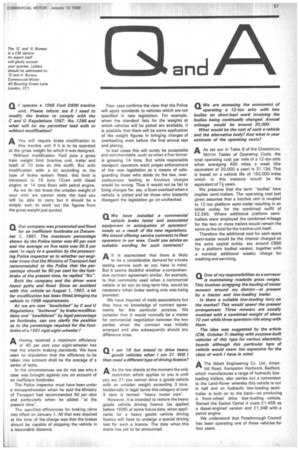• Our company was prosecuted and fined for an inefficient
Page 69

If you've noticed an error in this article please click here to report it so we can fix it.
footbrake on December 1, 1967. The maximum percentage shown by the Police tester was 40 per cent and the average on five tests was 364 per cent. In reply to a question by the prosecuting Police inspector as to whether our engineer knew that the Ministry of Transport had recommended to the Police that the percentage should be 50 per cent for the footbrake at the present time, he replied "No".
Both the company and the driver were found guilty and fined. Since an accident with this vehicle on August 1, 1967, a kit for modification has been fitted, bringing the vehicle to 1968 requirements.
As we are now "bewitched" by C and U Regulations, "bothered" by brake modfficadons and "bewildered" by legal percentage on footbrake, can you clarify the position as to the percentage required for the footbrake of a 1961 rigid eight-wheeler?
AHaving received a maximum efficiency
of 40 per cent your eight-wheeler has met the interim braking standards. We have seen no stipulation that the efficiency to be taken into account shall be the average of a series of tests.
In the circumstances we do not see why a case was brought against you on account of an inefficient footbrake.
The Police inspector must have been under a misapprehension when he said the Ministry of Transport had recommended 50 per cent and particularly when he added "at the present time-.
The specified efficiencies for braking came into effect on January 1. All that was required at the time of the charge was that the brakes should be capable of stopping the vehicle in a reasonable distance. Your case confirms the view that the Police will apply standards to vehicles which are not specified in new legislation. For example, when the standard lists for the weights at which vehicles will be plated are available, it is possible that there will be some application of the weight figures in bringing charges of overloading even before the first annual test and plating.
In bad cases this will surely be acceptable and commendable, such as when a five-tonner is grossing 14 tons. But while responsible transport operators want proper enforcement of the new legislation as a means of safeguarding those who abide by the law, overzealousness leading to frivolous charges would be wrong. Thus it would not be fair to bring charges for, say, a 5cwt overload when a vehicle is plated and let those who blatantly disregard the legislation go on unchecked.




















































































































